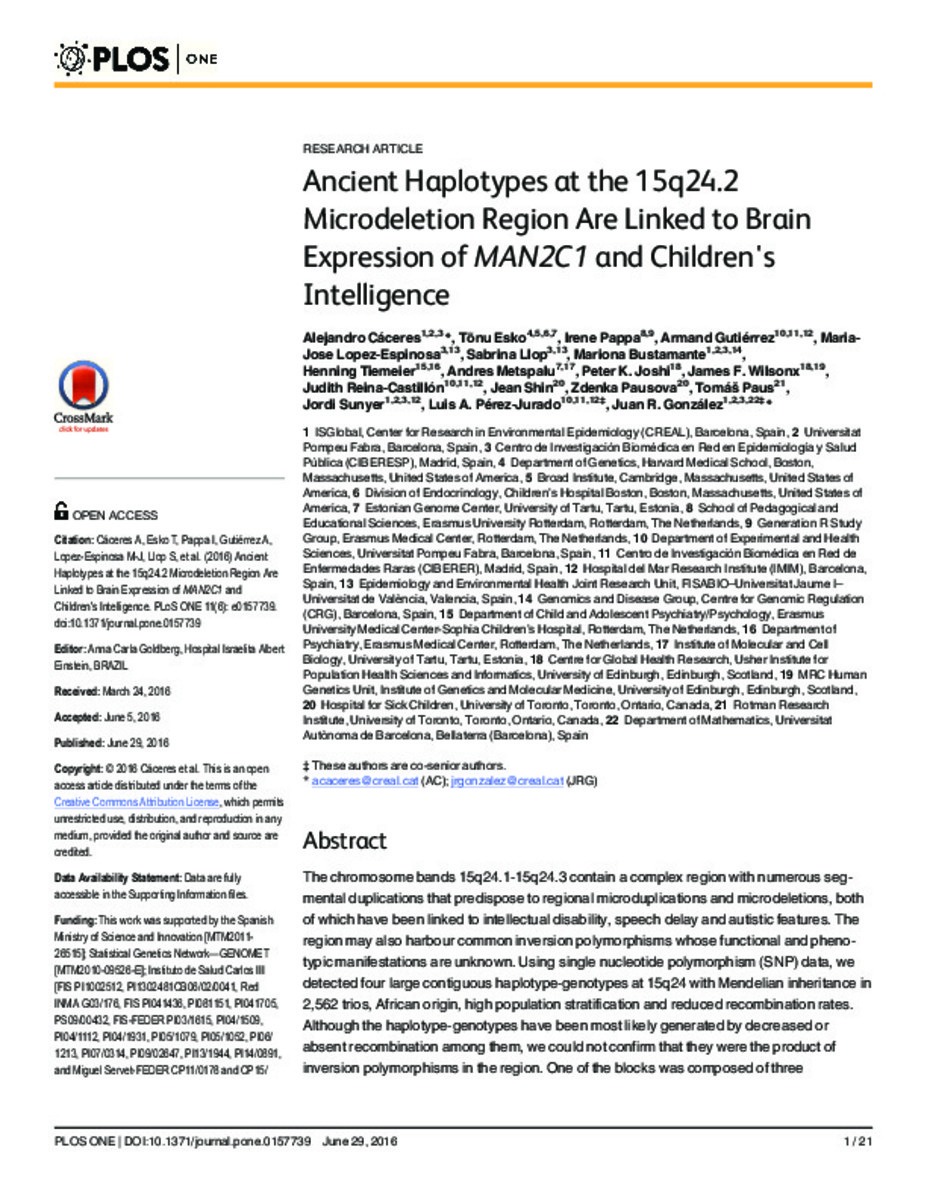Mostrar el registro sencillo del ítem
Ancient Haplotypes at the 15q24.2 Microdeletion Region Are Linked to Brain Expression of MAN2C1 and Children's Intelligence
| dc.contributor.author | Cáceres, Alejandro | |
| dc.contributor.author | Esko, Tonu | |
| dc.contributor.author | Pappa, Irene | |
| dc.contributor.author | Gutierrez, Armand | |
| dc.contributor.author | López Espinosa, María José | |
| dc.contributor.author | Llop, Sabrina | |
| dc.contributor.author | Bustamante, Mariona | |
| dc.contributor.author | Tiemeier, Henning | |
| dc.contributor.author | Metspalu, Andres | |
| dc.contributor.author | Joshi, Peter K. | |
| dc.contributor.author | Wilsonx, James F. | |
| dc.contributor.author | Reina Castillón, Judith | |
| dc.contributor.author | Shin, Jean | |
| dc.contributor.author | Pausova, Zdenka | |
| dc.contributor.author | Paus, Tomás | |
| dc.contributor.author | Sunyer Deu, Jordi | |
| dc.contributor.author | Perez-Jurado, Luis | |
| dc.contributor.author | González, Juan R. | |
| dc.date.accessioned | 2017-06-26T17:31:16Z | |
| dc.date.available | 2017-06-26T17:31:16Z | |
| dc.date.issued | 2016 | |
| dc.identifier.citation | Cáceres, A., Esko, T., Pappa, I., Gutiérrez, A., Lopez-Espinosa, M. J., Llop, S., ... & Wilsonx, J. F. (2016). Ancient haplotypes at the 15q24. 2 microdeletion region are linked to brain expression of MAN2C1 and children's intelligence. PloS one, 11(6), e0157739 | ca_CA |
| dc.identifier.issn | 1932-6203 | |
| dc.identifier.uri | http://hdl.handle.net/10234/168099 | |
| dc.description.abstract | The chromosome bands 15q24.1-15q24.3 contain a complex region with numerous segmental duplications that predispose to regional microduplications and microdeletions, both of which have been linked to intellectual disability, speech delay and autistic features. The region may also harbour common inversion polymorphisms whose functional and phenotypic manifestations are unknown. Using single nucleotide polymorphism (SNP) data, we detected four large contiguous haplotype-genotypes at 15q24 with Mendelian inheritance in 2,562 trios, African origin, high population stratification and reduced recombination rates. Although the haplotype-genotypes have been most likely generated by decreased or absent recombination among them, we could not confirm that they were the product of inversion polymorphisms in the region. One of the blocks was composed of three haplotype-genotypes (N1a, N1b and N2), which significantly correlated with intelligence quotient (IQ) in 2,735 children of European ancestry from three independent population cohorts. Homozygosity for N2 was associated with lower verbal IQ (2.4-point loss, p-value = 0.01), while homozygosity for N1b was associated with 3.2-point loss in non-verbal IQ (p-value = 0.0006). The three alleles strongly correlated with expression levels of MAN2C1 and SNUPN in blood and brain. Homozygosity for N2 correlated with over-expression of MAN2C1 over many brain areas but the occipital cortex where N1b homozygous highly under-expressed. Our population-based analyses suggest that MAN2C1 may contribute to the verbal difficulties observed in microduplications and to the intellectual disability of microdeletion syndromes, whose characteristic dosage increment and removal may affect different brain areas. | ca_CA |
| dc.description.sponsorShip | This work was supported by the Spanish Ministry of Science and Innovation [MTM2011-26515]; Statistical Genetics Network—GENOMET [MTM2010-09526-E]; Instituto de Salud Carlos III [FIS PI1002512, PI1302481CB06/02/0041, Red INMA G03/176, FIS PI041436, PI081151, PI041705, PS09/00432, FIS-FEDER PI03/1615, PI04/1509, PI04/1112, PI04/1931, PI05/1079, PI05/1052, PI06/1213, PI07/0314, PI09/02647, PI13/1944, PI14/0891, and Miguel Servet-FEDER CP11/0178 and CP15/0025]; Generalitat de Catalunya [2014SGR1468]; Spanish Ministry of Science and Innovation [SAF2008-00357]; the European Commission [HEALTH-F4-2007-201413, FP7-ENV-2011 cod 282957, HEALTH.2010.2.4.5-1]; Fundacio La Marato de TV3, Generalitat de Catalunya [CIRIT 1999SGR 00241]; Conselleria de Sanitat, Generalitat Valenciana to MJLE; Fundacion Roger Torne to MJLE; Canadian Institutes of Health Research to TP and ZP; Heart and Stroke Foundation of Quebec to ZP; The Canadian Foundation for Innovation to ZP; Erasmus Medical Centre, Rotterdam; Erasmus University Rotterdam; Netherlands Organization for Health Research and Development [ZonMw]; Netherlands Organization for Health Research and Development [2100.0074]; Estonian Government [SF0180142s08]; Estonian Research Roadmap through Estonian Ministry of Education and Research; Center of Excellence in Genomics [EXCEGEN]; University of Tartu [SP1GVARENG], Estonian Research Council [IUT2-2]; European Regional Development Fund; The Chief Scientist Office of the Scottish Government; The Royal Society; The MRC Human Genetics Unit; Arthritis Research UK and The European Union framework program [LSHG-CT-2006-018947]. LAPJ is funded by the Spanish Ministry of Health (FIS-PI1302481 co-funded by FEDER), the Generalitat de Catalunya (SRG1468-2014), the ICREA-Academia program, and also acknowledges support from the Spanish Ministry of Economy and Competiveness "Programa de Excelencia Maria de Maeztu" (MDM-2014-0370). | ca_CA |
| dc.format.extent | 21 p. | ca_CA |
| dc.format.mimetype | application/pdf | ca_CA |
| dc.language.iso | eng | ca_CA |
| dc.publisher | Anna Carla Goldberg, Hospital Israelita Albert Einstein, BRAZIL | ca_CA |
| dc.publisher | Public Library of Science | ca_CA |
| dc.relation.isPartOf | PloS one, 2016, vol. 11, núm. 6 | ca_CA |
| dc.rights | © 2016 Cáceres et al. This is an open access article distributed under the terms of the Creative Commons Attribution License, which permits unrestricted use, distribution, and reproduction in any medium, provided the original author and source are credited. | ca_CA |
| dc.rights | Atribución 4.0 Internacional | * |
| dc.rights.uri | http://creativecommons.org/licenses/by-sa/4.0/ | * |
| dc.subject | Chromosome 15q | ca_CA |
| dc.subject | Chromosome 15q24 2 | ca_CA |
| dc.subject | MAN2C1 gene | ca_CA |
| dc.title | Ancient Haplotypes at the 15q24.2 Microdeletion Region Are Linked to Brain Expression of MAN2C1 and Children's Intelligence | ca_CA |
| dc.type | info:eu-repo/semantics/article | ca_CA |
| dc.identifier.doi | https://doi.org/10.1371/journal.pone.0157739 | |
| dc.rights.accessRights | info:eu-repo/semantics/openAccess | ca_CA |
| dc.relation.publisherVersion | http://journals.plos.org/plosone/article?id=10.1371/journal.pone.0157739 | ca_CA |
| dc.type.version | info:eu-repo/semantics/publishedVersion |
Ficheros en el ítem
Este ítem aparece en la(s) siguiente(s) colección(ones)
-
MED_Articles [645]
Articles de publicacions periòdiques
Excepto si se señala otra cosa, la licencia del ítem se describe como: © 2016 Cáceres et al. This is an open access article distributed under the terms of the Creative Commons Attribution License, which permits unrestricted use, distribution, and reproduction in any medium, provided the original author and source are credited.








